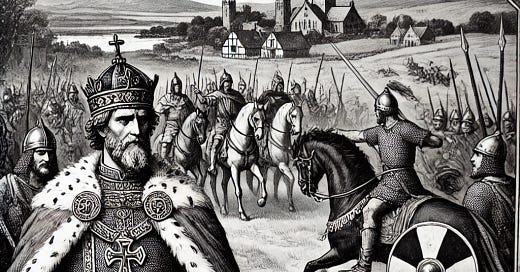Audio Version - Paid Subscribers
In the annals of early Scottish history, the figure of Hungus, King of the Picts, stands out as a valiant leader who played a crucial role in defending his realm against formidable enemies. The Battle of Athelstaneford, a pivotal event during his reign, highlights not only his military prowess but also the cultural and religious dimensions of his rule. This post delves into the life and legacy of Hungus, exploring his significant contributions to Pictish history and the broader context of early medieval Britain.
Historical Context: The Pictish Kingdom
To appreciate Hungus's achievements, we must first understand the Pictish kingdom he ruled. The Picts were a confederation of tribes in what is now Scotland, known for their distinctive culture, art, and fortified settlements. They were often in conflict with neighboring tribes and kingdoms, including the Scots, Britons, and Saxons. By the late 8th and early 9th centuries, the Pictish kingdom had become a significant power in northern Britain.
Hungus, also known as Angus, ascended to the Pictish throne during a period of intense regional strife. His reign is marked by efforts to consolidate Pictish power and defend against external threats. The most notable of these threats came from the Saxons, led by a figure named Athelstane.
The Saxon Threat
The conflict with the Saxons is central to Hungus's story. According to historical accounts, Athelstane, a Saxon leader, invaded Pictish territory, causing widespread devastation. This invasion prompted Hungus to seek assistance from his contemporary, Achaius, King of the Scots. Achaius responded by sending an army of 10,000 men, led by his son Alpin, to support Hungus in repelling the Saxon invaders.
The alliance between Hungus and Achaius underscores the complex political landscape of early medieval Britain. It also highlights the importance of inter-kingdom cooperation in the face of common enemies. This coalition set the stage for a decisive confrontation with the Saxons near the village of Athelstaneford.
The Battle of Athelstaneford
The Battle of Athelstaneford is a defining moment in Hungus's reign. Historical and legendary accounts blend to tell a story of courage, divine intervention, and ultimate victory. As the Pictish and Scottish forces prepared for battle, they faced a formidable Saxon army led by Athelstane.
Hungus, recognizing the gravity of the situation, turned to prayer for divine assistance. According to legend, St. Andrew, the Apostle, appeared to Hungus in a vision, promising him victory. This vision bolstered the morale of the Pictish and Scottish soldiers, who entered the battle with renewed vigor.
On the day of the battle, an illuminated St. Andrew’s cross reportedly appeared in the sky, a miraculous sign that struck fear into the hearts of the Saxons. This event, reminiscent of Constantine the Great’s vision, is said to have turned the tide in favor of Hungus and his allies. The Saxons, disheartened and disoriented by the celestial sign, were swiftly defeated. Athelstane himself was pulled from his horse and slain at the ford of Lug Down Burn, securing a significant victory for the Picts and Scots.
Aftermath and Legacy
The victory at Athelstaneford had far-reaching implications for Hungus and his kingdom. The miraculous appearance of the St. Andrew’s cross not only ensured a military victory but also reinforced the religious and cultural identity of the Picts. St. Andrew, who became the patron saint of Scotland, was honored through the establishment of the Order of the Thistle, a chivalric order dedicated to his memory.
The village near the battle site became known as Martle, likely derived from "miracle," commemorating the divine intervention that purportedly secured the victory. This victory also solidified Hungus's reputation as a capable and devout leader who successfully defended his kingdom against formidable foes.
Hungus in Historiography
The story of Hungus and the Battle of Athelstaneford is preserved in historical works such as George Buchanan’s "History" and the "Statistical Account of Scotland." These sources, while valuable, often blend historical facts with legendary embellishments. The vision of St. Andrew and the miraculous cross in the sky reflect medieval historians’ penchant for the marvelous and the divine.
The legend of St. Andrew’s vision is detailed in the "History of the Blessed Regulus and the Foundation of the Church of St. Andrew," written around 1140. This account aimed to bolster the religious and cultural significance of St. Andrew in Scotland, intertwining faith with national identity.
Conclusion: The Legacy of Hungus
Hungus, King of the Picts, remains a significant figure in Scottish history. His story, whether viewed through the lens of historical fact or legend, highlights the complexities of early medieval conflicts and the role of divine intervention in shaping historical narratives. Hungus's defense of his kingdom against Saxon invaders and the subsequent Battle of Athelstaneford exemplify the era's intricate interplay of warfare, religion, and cultural identity.
In unraveling the mystery of Hungus, we not only uncover the layers of myth and reality that define historical narratives but also appreciate the cultural and historical contexts that give rise to such enduring legends. Hungus's legacy, marked by his devout leadership and military acumen, remains a testament to the resilience and spirit of the Pictish people.





